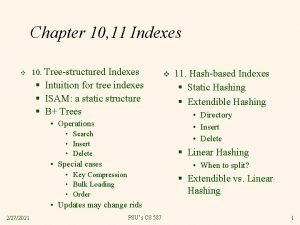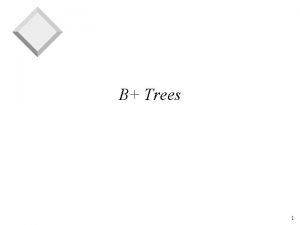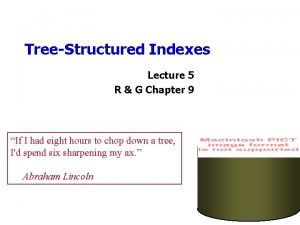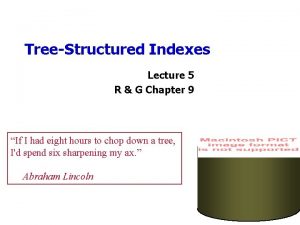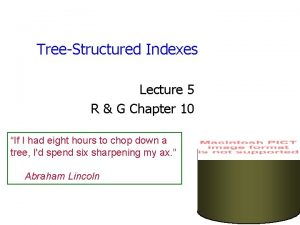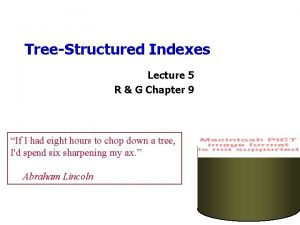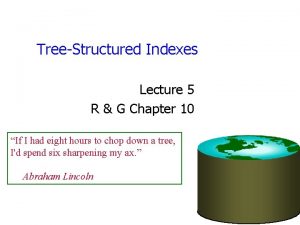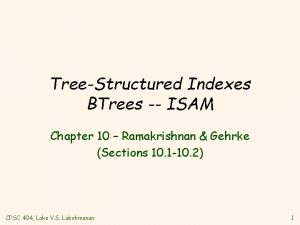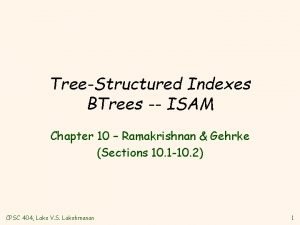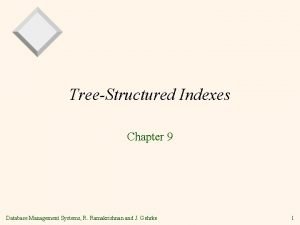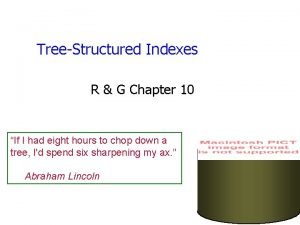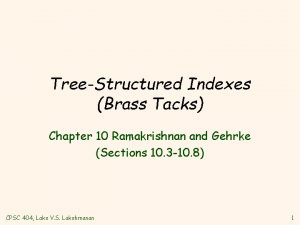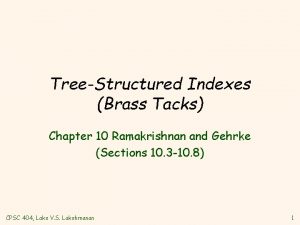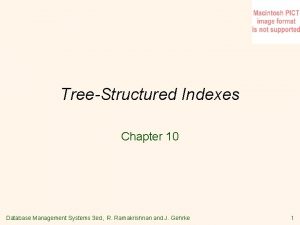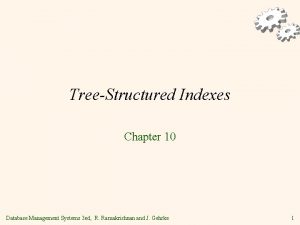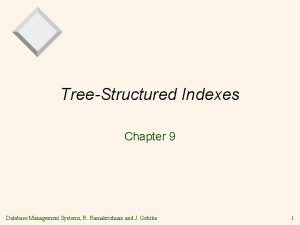TreeStructured Indexes Lecture 17 R G Chapter 9


































- Slides: 34

Tree-Structured Indexes Lecture 17 R & G Chapter 9 “If I had eight hours to chop down a tree, I'd spend six sharpening my ax. ” Abraham Lincoln

Administrivia • Homeworks re-arranged • Midterm Exam Graded – Scores on-line – Key available on-line I II Query Sorting III Joins IV Query Opt V Buffer Mgmt VI FDs VII ER Total Adjust w/EC Total 24 10 6 10 10 20 20 100 Avg 12. 5 7. 5 2. 2 2. 4 8. 1 12. 6 11. 1 56. 3 60. 0 Min 4. 0 0. 0 3. 0 23. 5 26. 1 Max 21. 0 10. 0 6. 0 8. 5 10. 0 20. 0 19. 0 82. 0 86. 7 90. 7 Std. Dev 3. 5 2. 9 1. 6 2. 1 4. 4 3. 7 10. 6 10. 8

Review • Last week: – How Internet Apps use Databases – How to access Databases from Programs – How to extend Databases with Programs • This week: – Tree Indexes (HW 4 or 5? ) – Hash Indexes • Next week: – Transactions – Concurrency Control

Today: B-Tree Indexes • Discussed costs/benefits in lecture 5 • Today more detail: – ISAM, an old fashioned Tree Index – B-Trees, most common DBMS tree index

Introduction • Recall: 3 alternatives for data entries k*: • Data record with key value k • <k, rid of data record with search key value k> • <k, list of rids of data records with search key k> • Choice is orthogonal to the indexing technique used to locate data entries k*. • Tree-structured indexing techniques support both range searches and equality searches. • ISAM: static structure; B+ tree: dynamic, adjusts gracefully under inserts and deletes. • ISAM = ? ? ? Indexed Sequential Access Method

A Note of Caution • ISAM is an old-fashioned idea – B+-trees are usually better, as we’ll see • Though not always • But, it’s a good place to start – Simpler than B+-tree, but many of the same ideas • Upshot – Don’t brag about being an ISAM expert on your resume – Do understand how they work, tradeoffs with B+-trees

Range Searches • ``Find all students with gpa > 3. 0’’ – If data is in sorted file, do binary search to find first such student, then scan to find others. – Cost of binary search can be quite high. • Simple idea: Create an `index’ file. – Level of indirection again! Page 1 Page 2 Index File k. N k 1 k 2 Page 3 Page N * Can do binary search on (smaller) index file! Data File

index entry ISAM P 0 K 1 P 1 K 2 P K m 2 • Index file may still be quite large. But we can apply the idea repeatedly! Non-leaf Pages Leaf Pages Overflow page * Leaf pages contain data entries. Primary pages Pm

Example ISAM Tree • Each node can hold 2 entries; no need for `next-leaf-page’ pointers. (Why? ) Root 40 10* 15* 20 33 20* 27* 51 33* 37* 40* 46* 51* 63 55* 63* 97*

Comments on ISAM Data Pages • File creation: Leaf (data) pages allocated sequentially, sorted by search key. Then index pages allocated. Then space for overflow pages. Index Pages Overflow pages • Index entries: <search key value, page id>; they `direct’ search for data entries, which are in leaf pages. • Search: Start at root; use key comparisons to go to leaf. Cost log F N ; F = # entries/index pg, N = # leaf pgs • Insert: Find leaf where data entry belongs, put it there. (Could be on an overflow page). • Delete: Find and remove from leaf; if empty overflow page, de-allocate. * Static tree structure: inserts/deletes affect only leaf pages.

Example ISAM Tree • Each node can hold 2 entries; no need for `next-leaf-page’ pointers. (Why? ) Root 40 10* 15* 20 33 20* 27* 51 33* 37* 40* 46* 51* 63 55* 63* 97*

After Inserting 23*, 48*, 41*, 42*. . . Root 40 Index Pages 20 33 20* 27* 51 63 51* 55* Primary Leaf 10* 15* 33* 37* 40* 46* 48* 41* Pages Overflow 23* Pages 42* 63* 97*

. . . then Deleting 42*, 51*, 97* Root 40 20 10* 15* 20* 27* 23* 51 63 33 33* 37* 40* 46* 55* 63* 48* 41* * Note that 51 ��appears in index levels, but 51* not

ISAM ---- Issues? • Pros – ? ? • Cons – ? ?

B+ Tree: The Most Widely Used Index • Insert/delete at log F N cost; keep tree heightbalanced. (F = fanout, N = # leaf pages) • Minimum 50% occupancy (except for root). Each node contains d <= m <= 2 d entries. The parameter d is called the order of the tree. • Supports equality and range-searches efficiently. Index Entries (Direct search) Data Entries ("Sequence set")

Example B+ Tree • Search begins at root, and key comparisons direct it to a leaf (as in ISAM). • Search for 5*, 15*, all data entries >= 24*. . . Root 13 2* 3* 5* 7* 14* 16* 17 24 19* 20* 22* 30 24* 27* 29* 33* 34* 38* 39* * Based on the search for 15*, we know it is not in the tree!

B+ Trees in Practice • Typical order: 100. Typical fill-factor: 67%. – average fanout = 133 • Typical capacities: – Height 4: 1334 = 312, 900, 700 records – Height 3: 1333 = 2, 352, 637 records • Can often hold top levels in buffer pool: – Level 1 = 1 page = 8 Kbytes – Level 2 = 133 pages = 1 Mbyte – Level 3 = 17, 689 pages = 133 MBytes

Inserting a Data Entry into a B+ Tree • Find correct leaf L. • Put data entry onto L. – If L has enough space, done! – Else, must split L (into L and a new node L 2) • Redistribute entries evenly, copy up middle key. • Insert index entry pointing to L 2 into parent of L. • This can happen recursively – To split index node, redistribute entries evenly, but push up middle key. (Contrast with leaf splits. ) • Splits “grow” tree; root split increases height. – Tree growth: gets wider or one level taller at top.

Example B+ Tree - Inserting 8* Root 13 2* 3* 5* 7* 14* 16* 17 24 19* 20* 22* 30 24* 27* 29* 33* 34* 38* 39*

Example B+ Tree - Inserting 8* Root 17 5 2* 3* 24 13 5* 7* 8* 14* 16* 19* 20* 22* 30 24* 27* 29* 33* 34* 38* 39* v Notice that root was split, leading to increase in height. v In this example, we can avoid split by re-distributing entries; however, this is usually not done in practice.

Inserting 8* into Example B+ Tree • Observe how minimum occupancy is guaranteed in both leaf and index pg splits. • Note difference between copyup and push-up; be sure you understand the reasons for this. … Entry to be inserted in parent node. (Note that 5 is s copied up and continues to appear in the leaf. ) 5 2* 3* 5* 17 5 13 24 7* 8* … Entry to be inserted in parent node. (Note that 17 is pushed up and only appears once in the index. Contrast this with a leaf split. ) 30

Deleting a Data Entry from a B+ Tree • Start at root, find leaf L where entry belongs. • Remove the entry. – If L is at least half-full, done! – If L has only d-1 entries, • Try to re-distribute, borrowing from sibling (adjacent node with same parent as L). • If re-distribution fails, merge L and sibling. • If merge occurred, must delete entry (pointing to L or sibling) from parent of L. • Merge could propagate to root, decreasing height.

Example Tree (including 8*) Delete 19* and 20*. . . Root 17 5 2* 3* 24 13 5* 7* 8* 14* 16* • Deleting 19* is easy. 19* 20* 22* 30 24* 27* 29* 33* 34* 38* 39*

Example Tree (including 8*) Delete 19* and 20*. . . Root 17 5 2* 3* 27 13 5* 7* 8* 14* 16* 22* 24* 30 27* 29* 33* 34* 38* 39* • Deleting 19* is easy. • Deleting 20* is done with re-distribution. Notice how middle key is copied up.

. . . And Then Deleting 24* • Must merge. • Observe `toss’ of index entry (on right), and `pull down’ of index entry (below). 30 22* 27* 29* 33* 34* 38* 39* Root 5 2* 3* 5* 7* 8* 13 14* 16* 17 30 22* 27* 29* 33* 34* 38* 39*

Example of Non-leaf Re-distribution • Tree is shown below during deletion of 24*. (What could be a possible initial tree? ) • In contrast to previous example, can re-distribute entry from left child of root to right child. Root 22 5 2* 3* 5* 7* 8* 13 14* 16* 17 30 20 17* 18* 20* 21* 22* 27* 29* 33* 34* 38* 39*

After Re-distribution • Intuitively, entries are re-distributed by `pushing through’ the splitting entry in the parent node. • It suffices to re-distribute index entry with key 20; we’ve re-distributed 17 as well for illustration. Root 17 5 2* 3* 5* 7* 8* 13 14* 16* 20 17* 18* 20* 21* 22 30 22* 27* 29* 33* 34* 38* 39*

Prefix Key Compression • Important to increase fan-out. (Why? ) • Key values in index entries only `direct traffic’; can often compress them. – E. g. , If we have adjacent index entries with search key values Dannon Yogurt, David Smith and Devarakonda Murthy, we can abbreviate David Smith to Dav. (The other keys can be compressed too. . . ) • Is this correct? Not quite! What if there is a data entry Davey Jones? (Can only compress David Smith to Davi) • In general, while compressing, must leave each index entry greater than every key value (in any subtree) to its left. • Insert/delete must be suitably modified.

Bulk Loading of a B+ Tree • If we have a large collection of records, and we want to create a B+ tree on some field, doing so by repeatedly inserting records is very slow. – Also leads to minimal leaf utilization --- why? • Bulk Loading can be done much more efficiently. • Initialization: Sort all data entries, insert pointer to first (leaf) page in a new (root) page. Root 3* 4* Sorted pages of data entries; not yet in B+ tree 6* 9* 10* 11* 12* 13* 20* 22* 23* 31* 35* 36* 38* 41* 44*

Bulk Loading (Contd. ) Root • Index entries for leaf pages always entered into right-most index page just above leaf level. When this fills up, it splits. (Split 3* may go up right-most path to the root. ) • Much faster than repeated inserts, especially when one considers locking! 10 12 6 4* 6* 9* 23 not yet in B+ tree 20 10 6* 9* Data entry pages 35 10* 11* 12* 13* 20*22* 23* 31* 35* 36* 38*41* 44* Root 6 3* 4* 20 12 Data entry pages not yet in B+ tree 35 23 38 10* 11* 12* 13* 20*22* 23* 31* 35* 36* 38*41* 44*

Summary of Bulk Loading • Option 1: multiple inserts. – Slow. – Does not give sequential storage of leaves. • Option 2: Bulk Loading – Has advantages for concurrency control. – Fewer I/Os during build. – Leaves will be stored sequentially (and linked, of course). – Can control “fill factor” on pages.

A Note on `Order’ • Order (d) concept replaced by physical space criterion in practice (`at least half-full’). – Index pages can typically hold many more entries than leaf pages. – Variable sized records and search keys mean different nodes will contain different numbers of entries. – Even with fixed length fields, multiple records with the same search key value (duplicates) can lead to variable-sized data entries (if we use Alternative (3)). • Many real systems are even sloppier than this --only reclaim space when a page is completely empty.

Summary • Tree-structured indexes are ideal for range-searches, also good for equality searches. • ISAM is a static structure. – Only leaf pages modified; overflow pages needed. – Overflow chains can degrade performance unless size of data set and data distribution stay constant. • B+ tree is a dynamic structure. – Inserts/deletes leave tree height-balanced; log F N cost. – High fanout (F) means depth rarely more than 3 or 4. – Almost always better than maintaining a sorted file.

Summary (Contd. ) – Typically, 67% occupancy on average. – Usually preferable to ISAM, adjusts to growth gracefully. – If data entries are data records, splits can change rids! • Key compression increases fanout, reduces height. • Bulk loading can be much faster than repeated inserts for creating a B+ tree on a large data set. • Most widely used index in database management systems because of its versatility. One of the most optimized components of a DBMS.
 What is logical view of data
What is logical view of data Miller indices for planes
Miller indices for planes Blue-chip indices
Blue-chip indices Scale scores convey more information than index scores.
Scale scores convey more information than index scores. Security market indexes
Security market indexes Indexes
Indexes Laspeyres price index
Laspeyres price index Productivity index
Productivity index Profitability index calculator excel
Profitability index calculator excel Sys.partitions
Sys.partitions Differentiating factors in constructing market indexes
Differentiating factors in constructing market indexes 01:640:244 lecture notes - lecture 15: plat, idah, farad
01:640:244 lecture notes - lecture 15: plat, idah, farad Human resource management 15th edition
Human resource management 15th edition Intro to human resource management
Intro to human resource management Human resource management lecture chapter 1
Human resource management lecture chapter 1 Project procurement management lecture notes
Project procurement management lecture notes Lecture about sport
Lecture about sport Lecture on healthy lifestyle
Lecture on healthy lifestyle Existentialism vs nihilism
Existentialism vs nihilism Meaning of this
Meaning of this Randy pausch the last lecture summary
Randy pausch the last lecture summary Tensorflow lecture
Tensorflow lecture Theology proper lecture notes
Theology proper lecture notes Strategic management lecture
Strategic management lecture Geology lecture series
Geology lecture series Social psychology lecture
Social psychology lecture In text citation for a lecture
In text citation for a lecture Advantages of government accounting
Advantages of government accounting 4 p's of project management in software engineering
4 p's of project management in software engineering Practical design to eurocode 2
Practical design to eurocode 2 Magnetism
Magnetism Classical mechanics
Classical mechanics Physics 101 lecture
Physics 101 lecture Physical science lecture notes
Physical science lecture notes Power system dynamics and stability lecture notes
Power system dynamics and stability lecture notes



































